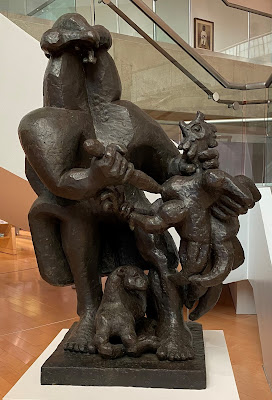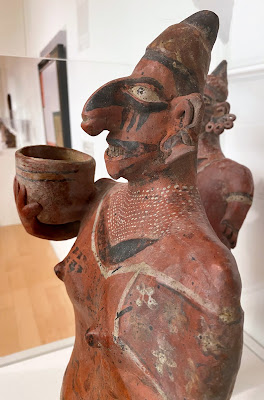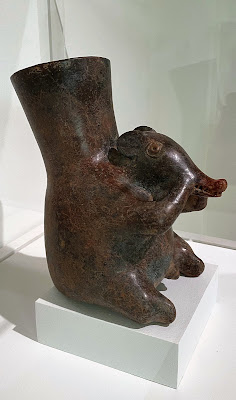I started with a temporary exhibit across the street from the museum.
is artist Gonzalo Lebrija's recreation of a piece of performance art when he used a crane to drop a car into a lake while filming it with a high-speed camera. This is the moment just before the car hits the water.
Cute until you see that the babies' faces are replaced by a bar code--the artist's commentary on the dehumanization of society.
Back to the museum. On first (and second and third) glance, I thought this was the head of an alien lifeform. Artificial Rock #131 (2012) by Chinese artist Zhan Wang actually references the rocks in Chinese meditation gardens that are selected for their fantastic shapes.
Also outside are two Henry Moore sculptures.
 |
| Two Piece Reclining Figure No. 3 (1961) |
 |
| Reclining Figure (1956) |
One of my favorite artworks in the entire museum was the first thing I saw in the lobby: a stainless steel and glass sculpture by British-American artist Anthony James called
80" Great Rhombicosidodecahedron (2020). As the name implies, it is 6' 8" in diameter and contains an infinity of shapes. It is almost hypnotic to look into its interior spaces (photo on right), and I have absolutely no idea how the artist created it. For more of his geometric sculptures, see
his website.I decided to work from the bottom up, which meant I would get the sculpture garden out of the way when it was just 100° rather than 110°.
 |
Twin 6' Hearts (2002) by Jim Dine
|
 |
| Heavy Handed (2014) by Nathan Mabry |
 |
Man with World at Feet (2003)
by Viola Frey
|
I am a huge Dale Chihuly fan and would LOVE to have one of these orbs in my yard. They can't be that expensive, right, Bob? Chihuly calls these Floats (1995).
Or how about these? You keep telling me you want a cactus garden. These are pointy. And sharp.
 |
| Red Reed Installation (1997) by Dale Chihuly |
I like this one too, but I don't want her in my garden.
 |
Sitting Woman (1987)
by Stephen De Staebler |
This makes me think of a rattlesnake. Bob, you should like this one.
 |
Buddha's Gate #1 (1986) by Michael Todd
|
Whoa, just a bit creepy. The figure is headless and the torso and legs are only half there.
 |
| Reclining Figure (For Rome) (2013) by Thomas Houseago |
There was a hallway lined with art on the lower floor. Oh my gosh! Another throwback to Cadillac Ranch!
 |
| Cadillac Ranch, Amarillo, Texas (1979) by Robert A. Widdicombe |
Back on the main floor, I started in the Western Heritage area. My husband has been obsessed with bird-watching at the Salton Sea lately, so I took this one for him. (In fact, that's where he was while I was at the museum.)
 |
| Smoke Tree and Salton Sea (1935) by James Swinnerton |
 |
| Horse (1978) by Deborah Butterfield [made of mud and sticks] |
As far as western art goes, this is pretty hilarious. It includes a laughing Lone Ranger who has just been shot by a child holding a toy gun while being observed by Mickey Mouse. According to the information on the painting, "Anger, nostalgia for the past, apprehension for the future, and changing values are suggested in this complex work." Okay, not hilarious.
 |
| The Last Outpost (1983) by Llyn Foulkes |
Close-up of the shooter:
Can you tell what this quilt-like painting says? It was made by a Choctaw Cherokee and includes many Native American motifs.
 |
| To Say I Love You Right Out Loud (2019) by Jeffrey Gibson |
What looks like a traditional bowl woven from grasses is my favorite work in the American West section. Continuum Basket: Pivat (Tobacco) (2018) by Gerald Clarke is actually made of aluminum beer and soda cans mounted on a satellite dish. What an interesting--and disturbing--blending of cultures.
And speaking of blending cultures, based on the title of this work, I think it is meant to look like an American Girls Doll still in the box--Native American style.
 |
| First American Girl Series: "Naomi" (2018) by Cara Romero |
I love the feeling of motion and the glow of this painting. It makes me think of a solar system.
 |
| La Brea (Moving Paint Series) (1967) by Claire Falkenstein |
I think this art museum is the place I saw my first piece of Chihuly glass many years ago. Since then the museum has expanded its glass collection to include, among many other pieces,
Luna Gris [gray moon?] (2014) by Karen Bexfield and what I call
Life Saver Chair but which is actually named
Sitting Nude (Buddha) (2004) by Ivana Šrámková.
This glass piece is my favorite. It looks like aspens and seems to refer to the line in Robert Frost's poem "Stopping by the Woods on a Snowy Evening," which reads, "The woods are lovely, dark and deep."
 |
| These Woods Are Dark and Deep I Know... (2010) by Lisa Cahill |
Of course a piece by Chihuly is included in the exhibit. It has a rather cumbersome name.
 |
| White and Pink Seaform Set with White and Black Lip Wraps (1985) by Dale Chihuly |
Jacques Lipchitz was a Cubist sculptor from Lithuania whom I have grown to appreciate because of my artist son. When he moved to Paris to study art, he became friends with Picasso and Modigliani. A Jew, he was able to escape Europe before being caught in the Nazi net and ended up in Hastings-on-Hudson, New York. Below is his bronze sculpture
Sacrifice III (1949, cast in 1957).
On the second floor I found a collection of Hispanic art.
 |
Seated Boy with Toy (ca. 1945)
by Gustavo Montoya |
 |
Bathers (study for El Bano en Tehuantepec,
a mural in Mexico City) (1925)
by Diego Rivera |
The museum has some nice Mesoamerican pottery, including Female Holding a Bowl (100 BCE-400 CE), found in Nayarit, Mexico, and Armadillo Effigy (200 BC - 200 CE), found in Colima, Mexico.
I loved the ladybugs on this modern pottery piece.
 |
| Polychrome Seed Jar (2013) by Barbara Cerno, Acoma Hopi |
And in keeping with the desert American or Mesoamerican theme . . .
 |
| Lizard (1968) by Alexander Calder |
A few more sculptures before I moved up to the third floor. L: Woman (Seated Torso) (1957-58) by Henry Moore, apparently a favorite artist of this museum. R: Large Horse with Six Heads (1954-56) by Germaine Richier.
Of all the sculptures in the museum, however, this was definitely my favorite. Any guess who the artist is?
 |
| Angry Owl, or Owl with Raised Wings (1950) |
Here is a head-on view.
Have you figured it out yet? I don't think I would have ever guessed this is by . . . .
Pablo Picasso! I would love a copy for our home. My husband loves owls.
Now I am on the third floor with more contemporary art. This 3-D looks like the shifting desert sand.
 |
| Sinuzoide [sine curve] (1974) by Marc Cavell |
After the Picasso owl, my next favorite sculpture is this one made of steel blocks.
 |
| Apart X (2003) by Antony Gormley |
Or maybe my next favorite is this one, which imagines Topsy, a slave girl character in Harriet Beecher Stowe's book
Uncle Tom's Cabin. The artist depicts her dressed in armor, carrying a tobacco knife, and with a cotton crown for hair.
 |
| Tobacco (2018), by Alison Saar |
NOT my favorite but still intriguing is this giant S
pider (1995) by the queen of spiders, Louise Bourgeois, who is most famous for her enormous spiders (30+ feet tall) that are usually outdoor installations. We saw one at
Pappajohn Sculpture Park and one in Tokyo.
The same artist who created the sitting boy out of metal blocks also created this work out of bread, which shows a fetal body surrounded by bread--a life-supporting material. It is entitled
Mother's Pride, which is the brand name of the highly processed bread he used to create the work--much like our Wonder Bread.
I include this not because I liked it so much, but because two-and-a-half years ago we visited t
he Donald Judd home and museum near Marfa, Texas. I always enjoy making connections between pieces that I see in different museums around the country/world.
 |
| Untitled (DJ 88-45 Menziken) (1988) by Donald Judd |
 |
Painted Wall Sculptures: Light Green Panel and
Red-Orange Panel (1981-1982) by Ellsworth Kelly |
This painting caught my eye mainly because I am familiar with the artist's husband, painter Willem de Kooning, whose paintings I have seen in many museums.
 |
| Man Hiding (1956) by Elaine de Kooning |
This creator of these concentric circles became famous for winning the national competition for a Vietnam Memorial design, the famous wall of names. Here, she has carved out three separate circles from Vermont marble and combined them into one piece of art. Any guesses what they represent before you read the caption?
 |
From inside circle working out: Arctic Circle (2013),
Latitude New York City (2013), and Equator (2014) by Maya Lin |
Close-up view of the "mountains" on the equator:
I really like this very large piece made with acrylic, spirulina and--of all things--staples!
Nonceptual Space (2009) is by Vietnamese-American artist Tam Van Tran.
Is this the female equivalent of the Washington Irving's Headless Horseman? It is entitled
Nossis, the name of a female Hellenistic Greek poet active in the 3rd century BC. The lack of a head is apparently a commentary on how women have always been defined by men rather than by their own words.
 |
| Nossis (1999) by Anselm Kiefer |
Another piece by Kiefer, whose work is often focused on processing the horrors of the past in his native Germany, including the Holocaust. I don't know if this painting/sculpture fits into that theme, but I found it to be very powerful.
 |
| L'Ascension (1978-2008) by Anselm Kiefer |
Another one of my favorites, this large work looks like an old billboard that has been through a few storms. It was actually inspired by a series of billboards in Leimert Park, an area of Los Angeles where a serial killer was apprehended in 2010. Police found photos of African American women in the killer's possession and posted them on billboards in hope of finding additional victims, at the same time violating any privacy the dead women and their families deserved. Look carefully to find headlines, bits of news, and photos.
 |
| Rat Catcher of Hamelin IV (2011) by Mark Bradford |
This pioneer-style bonnet might win the prize for being the weirdest thing in the museum. Entitled Seer Bonnet XVIII (Ruth), it was created in 2011 by American artist Angela Ellsworth from 31,863 pearl corsage pins, fabric, steel, and wood. The pin heads create a beautiful design, but the sharp metal tips are pointed towards the wearer.




Anyone who has ever had a sink full of dirty dishes (in other words, everyone) can relate to this 8-foot-tall stack of plastic plates.
 |
| Stacked Plates, Butter (2007) by Robert Therrien |
Another artist whose work is in many museums is Edward Ruscha, a Californian who has been very influential in the PopArt movement. I like this piece created in 1980, which looks like some alien planet landscape.
If you look very closely at the two ends of the "spectrum," you will see the words of the title: Intense Curiosity - Gross Neglect. While there seems to be a vast space between the two extremes, it also seems that it would be a fairly easy amble to get from one end to the other.
And finally, this large assemblage from found objects. The artist, Noah Purifoy, was an influential figure in LA's Black Arts Movements and got his start constructing sculptures from the debris of the 1965 Watts riots. In the late 1980s he moved to Joshua Tree, and this relief is made from things he found in a junkyard there--radiator parts, polished plaques, etc.
 |
| Untitled (2000) by Noah Purifoy |
After a couple of hours in the museum, I was hungry and wanted lunch before heading home. It was hot outside--about 110° F, but I had scouted out a restaurant not too far away where I could get take-out: Palm Greens Cafe, which boasted that it had "organic cuisine." Unfortunately, they did not pick up the phone for my call-in order. Oh well, it wasn't far, so I decided I would drive over, order, and wait.
The menu looked great--lots of things on there that I wanted to try. I ended up with the Avocado Roll in a Bowl, which turned out to be a good choice. I also ordered a chocolate date shake (not shown on this menu) to help with the heat.
Then I waited. And waited. I had to wait outside because it was so crowded inside, but they had a little alley that had a mister going, so it wasn't too bad.
In the end I thought the food was worth the inconveniences.
However, I would be more likely to go again if I could order ahead so that I didn't have to wait so long. The wait to get a table was also about 30 minutes. Clearly, this is a popular Palm Springs hang out!

























































































Looks like it was a fun day.
ReplyDeleteI'm glad you had some time at the museum. You are getting quite knowledgeable about art. It is fun to see that side of your life develop.
ReplyDelete